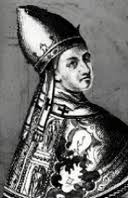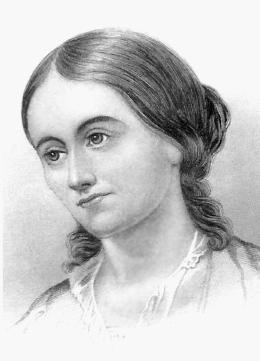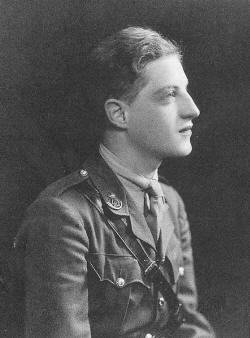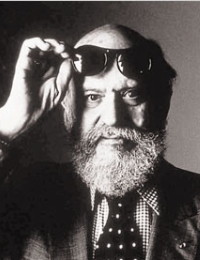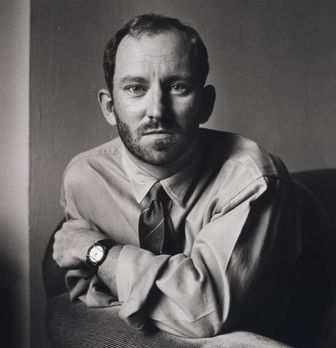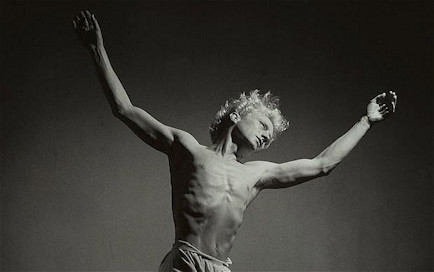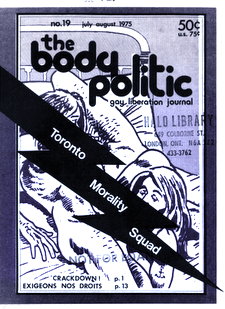|
presents THIS DAY IN GAY HISTORY based on: The White Crane Institute's 'Gay Wisdom', Gay Birthdays, Gay For Today, Famous GLBT, glbt-Gay Encylopedia, Today in Gay History, Wikipedia, and more …
Collected by Ted May 23 [{(o)}]|[{(o)}]|[{(o)}]|[{(o)}]| [{(o)}]|[{(o)}]
c.1012 – Benedict IX (d.circa 1056), born in Rome as Theophylactus of Tusculum, was Pope on three occasions between 1032 and 1048. Aged approximately 20 at his first election, he is one of the youngest popes in history. Unqualified by his youth, his bringing up, his depravity, Benedict IX became one of the very few really disreputable popes. He is the only man to have been Pope on more than one occasion, the only man ever to have sold the papacy, and the first verifiable person to have resigned the papacy. He was also the first pope known to be primarily homosexual. Benedict's pontificate, which was known for homosexual orgies in the Lateran Palace, "turned the Vatican into a male brothel" and was so scandalous that he was deposed, not once but twice. Benedict was deposed in 1045, but then reinstated, only to be deposed again. He disappeared into such deep obscurity that his actual date of death is unknown. According to one report, which it may be hoped is true, Benedict retired to the abbey of Grottaferrata, resigned all claim to the papacy, and spent his last years as a penitent.
1791 – France creates a new law system where rape is the only punishable sex crime. Sodomy, a former capital offense, is not included, leading France to be the first country to decriminalize sex between men.
1810 – Today is the birthday of the American journalist, critic, women's rights advocate and transcendentalist Margaret Fuller, nee Sarah Margaret Fuller Ossoli, (d.1850), the first editor of Ralph Waldo Emerson's "The Dial" and the first female journalist to work on the staff of a major newspaper. Edgar Allan Poe once remarked that "Humanity is divided into Men, Women, and Margaret Fuller." Her biographers have written of her harboring "homosexual traits" because of lines like these:
"It is so true that woman may be in love with a woman and
a man with a man. It is pleasant to be sure of it, because it is undoubtedly the
same love that we shall feel when we are angels. It is regulated by the same
laws as that of love between persons of different sexes, only it is purely
intellectual, spiritual, unprofaned by any mixture of lower instincts, undisturbed by
any need of consulting temporal interests; its law is the desire of the spirit to
realize a whole, which makes it seek in another being that which it finds not in
itself."
c.1897 – Gabriel Atkin was a British artist. Born William Park Atkin, Gabriel Atkin was born in South Shields, Durham, the son of a builder (d.1937). Before the First World War he showed promise as a water-colourist and he studied briefly at Armstrong College in Newcastle with tutor Richard George Hatton. With the start of the war he enlisted and in the summer of 1915 he was sent to Cambridge for officer training. While there he got to know the circle of gay men including the academics Edward Dent and A. T. 'Theo' Bartholomew. Although Atkin could be charming he was also prone to drunkenness and riotous behaviour, which caused those around him embarrassment and anguish. They engaged in some matchmaking and encouraged Siegfried Sassoon to meet Atkin. The meeting took place when Siegfried Sassoon travelled to Margate, where Gabriel Atkin was staying. The meeting went well and they immediately fell for each other. They spent that Christmas together at Siegfried Sassoon's family home at Weirleigh and at Robert Ross's rooms in Half Moon Street in London. Gabriel Atkin almost certainly provided Siegfried Sassoon with his first sexual encounter. 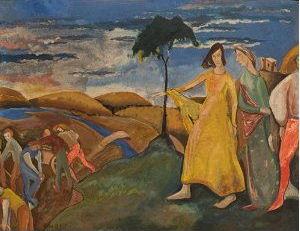 A Gabriel Atkin watercolor After this Siegfried Sassoon became a minor literary celebrity and got to know a number of well-known people. This meant that Gabriel Atkin also got to know them. Sacheverell Sitwell introduced Siegfried Sassoon to Ronald Firbank. Although Siegfried Sassoon did not find Ronald Firbank's work appealing they met a couple more times mainly because Atkin was a devotee. They had also got to know some of the Bloomsbury Set including Lytton Strachey, Mark Gertler, Duncan Grant, and John Maynard Keynes. Gabriel Atkin had a show at the London Salon in 1919. In 1920 Atkin was living in a studio flat in Tite Street in Chelsea, London, and Siegfried Sassoon gave him an allowance of £300 so that he could continue painting. They began to see much less of each other, although Siegfried Sassoon continued to send money for some years. Gabriel Atkin travelled to France and for a while was a male prostitute in Lyon and then the south of France. In 1928 he met the minor writer Mary Butts, and they married in London in 1930. For the first two years of their marriage they lived in London and Newcastle. They then settled in Sennen in Cornwall and bought a cottage that they called Tebel Vos. They both relied on drink and drugs. The marriage was troubled and Gabriel Atkin left in 1934. By 1937 they were both dead.
1914 – Leo Lerman (d.1994) was an American writer and editor who worked for Condé Nast Publications for more than 50 years. Lerman also wrote for the New York Herald Tribune, Harper's Bazaar, Dance Magazine, and Playbill. Lerman was born in New York City, the son of Jewish immigrants from Eastern Europe. He grew up in East Harlem and Queens, New York. As a child, he accompanied his house-painter grandfather and father on various jobs in upper-class homes. He was openly gay. From earliest adolescence, he knew he was homosexual and that he was highly sensual - inclinations that did not remotely worry his doting, manipulative mother. As a teenager, he overheard "Momma" tell one of his aunts on the phone, "He will never get married. So what if he's a 'mother's boy'?" she added. "I'm his mother." As a struggling writer, he leavened his spirits by giving parties for the beau monde and the haut monde, first in a shabby-chic walk-up he shared with his first love, the painter Richard Hunter; later in a brownstone on Lexington Avenue, where he lived for 20 years with Foy; and then at a sprawling duplex in the Osborne on 57th Street, where they moved in 1967. Lerman's parties attracted everyone from magazine editors and writers to Maria Callas, Anaïs Nin, Margot Fonteyn, Frederick Ashton, Cecil Beaton, Diana and Lionel Trilling, Aaron Copland, Gloria Steinem and Leonard Bernstein. After Lerman died in 1994, not long after his 80th birthday, his lifelong love and partner, the artist Gray Foy, discovered hundreds of notebooks secreted in a warehouse, file drawers and even a trunk under the piano he'd converted to a desk, "stretching from the months before his first Vogue assignment (in 1941) to a year before his death."Stephen Pascal, Lerman's assistant at Vogue, Vanity Fair and Condé Nast for more than 12 years, and later, his amanuensis, took on the daunting task of editing this material. Selections from his journals, roughly 10 percent of the writings, were published in 2007 as The Grand Surprise: The Journals of Leo Lerman. Meant to be the source material for a novel he never wrote, the journals detail his social and business interactions with a remarkable number of famous and important people who passed through the New York arts scene from the 1940s to the '90s. Among the memories: He once flatly rejected a "Narcissus naked" Yul Brynner, who was begging him to sleep with him and pathetically murmuring, "Why won't you? Why won't you?" The first, and probably only, woman Lerman ever saw naked was his great friend Marlene Dietrich, at a time when she was having what he described in a diary entry as an "intense affair with Yul." According to Lerman's lifelong love and partner, the artist Gray Foy, Dietrich had asked Lerman into her bath to demonstrate "the female anatomy." Apparently, Lerman took in the view with respectful attention, if not passion.
1920 – Harvard establishes a committee to investigate homosexual activity on campus. The tribunal becomes known as the Secret Court of 1920. Records of the tribunal are discovered in 2002. Many of those interrogated were never charged and have not been identified. In 2002, a researcher from The Crimson, the school's undergraduate daily newspaper, came across a box of files labeled "Secret Court" in the University Archives. After a protracted campaign on the part of the paper's staff, the university released five hundred documents relating to the Court's work. An article by Amit R. Paley in The Crimson's weekly magazine Fifteen Minutes reported the 1920 events on November 21, 2002.
1955 – Allen Barnett (d.1991) is the author of The Body and Its Dangers and Other Stories (1990), a collection of short stories unlikely to be surpassed for its depiction of gay life at the height of the AIDS pandemic. Barnett was born in a small town near Joliet, Illinois, the oldest of seven children. Barnett described his family as "dysfunctional." His mother temporarily put all seven children into a Roman Catholic orphanage when she found herself unable to care for them. Following graduation, Barnett moved to New York City, initially to seek work as an actor, but eventually enrolling in a Master's degree program in liberal studies. In 1979, he transferred to the Master of Fine Arts program in creative writing at Columbia University. During the 1980s, Barnett was active in gay literary and social circles, summering on Fire Island, and making friends with and receiving professional advice from such diverse talents as Robert Ferro and Richard Howard. In 1985 he helped to found the Gay and Lesbian Alliance against Defamation (GLAAD). In the late 1980s Barnett worked for opera agent Herbert Breslin, who was impressed by Barnett's writing. Breslin asked a mutual friend to forward Barnett's stories to Michael Denneny, an influential editor at St. Martin's Press, where Denneny had founded the Stonewall Inn Editions, a groundbreaking series in gay and lesbian letters. Denneny not only contracted to publish The Body and Its Dangers and Other Stories, but placed one of the stories in the highly influential New Yorker magazine in advance of the book's publication. Barnett had less than one year to enjoy the resulting acclaim. He died on August 14, 1991, of AIDS-related causes, having earlier been treated for Kaposi's Sarcoma in the lungs.
1960 – Nigel Charnock, British dancer extraordinaire, was born near Manchester, England (d.2012). He was one of the two founders of the celebrated company DV8 Physical Theatre, and an exuberantly maverick performer and innovator on his own account. After briefly considering training in social work, he was bitten by the punk bug and studied drama at the Welsh College of Music and Drama for three years. From there he went to the London School of Contemporary Dance, then becoming a test bed for experimentalism. On finishing his training, Charnock and his near-contemporary Lloyd Newson joined the radical Extemporary Dance Theatre, known for work drawing on punk, sex and improvisation from choreographers such as Michael Clark and Laurie Booth. The atmosphere of innovation influenced Newson and Charnock when in 1985 they left to set up DV8. Charnock frequently ripped off his clothes in performance, and used his almost masochistic fearlessness to shocking effect in his early work with DV8 (the name was a play on the word "deviate"). A duet which he and his partner Lloyd Newson created in 1985, My Sex, Our Dance, devised a dance language drawing on violent sexual aggression and raw physical excitement which soon put the company at the forefront of daring in dance-theatre. Two years later DV8 became internationally famous with the remarkable all-male work, inspired by the thrill of casual sexual encounters , Dead Dreams of Monochrome Men, which was filmed in 1989 by The South Bank Show . Charnock also went solo, devising a sometimes offensive trio of shows for small theatres. He exploited his emotional schism between religious longing and homosexual needs, with nudity one of his trademarks, hurling his body on to the floor or draping himself over members of the audience while ranting or singing non-stop. The three pieces – Resurrection, Original Sin and Hell Bent – generated both delight and outrage in audiences. He continued to create solo shows on similar lines through his career, notably Frank, a 2002 commission from the Venice Biennale, and the autobiographical One Dixon Road, which he performed when he turned 50 in 2010. Charnock was diagnosed with cancer only six weeks before his death in a London hospice.
1969 – In this day’s issue of the American porno magazine Screw, a column appears by Jack Nichols and Lige Clarke using the term homophobia to refer to straight men’s fear that they might be gay. Screw is usually a straight man’s magazine.
1978 – In Eugene, Oregon residents voted to repeal an ordinance banning discrimination against Gays and Lesbians by a 2-to-1 margin.
1979 – Chris Morris is an activist who, aged 15, with Euan Sutherland, successfully challenged the British Government in the European Court of Human Rights and secured an equal age of consent for sexual activity between males. He went on to study psychology and work as a political speechwriter and consultant. When male homosexuality was decriminalised in England and Wales in 1967, the age of consent was set at 21. It was lowered to 18 in 1994, but Morris and Sutherland took their case to the European Court to demand it be reduced further to 16, the same age as it is for heterosexuals. They invoked the European Convention on Human Rights, which guarantees the right to a private life and protection from discrimination. Their case was originally backed by the gay rights group Stonewall and later Morris formed his own organisation, YouthSpeak, which was funded by Sir Ian McKellen. YouthSpeak sent delegations of teenagers to meet MPs and the media to tell their personal stories about how an unequal age of consent affected their lives. The group also projected a laser beam onto Big Ben demanding "16 for everyone" and delivered a 25,000-strong petition to new prime minister Tony Blair when he was elected in May 1997. Opposition to the campaign was led by Conservative peer Baroness Young and the then Archbishop of Canterbury, George Carey, among others. In July 1997, the European Court found that the existence of different ages of consent was discriminatory and that no valid grounds existed to justify that discrimination. They therefore found that the age of consent for homosexual acts should be lowered to 16. In response to the court's findings, the then Home Secretary Jack Straw agreed with Sutherland and Morris that a Bill would be proposed to Parliament in the summer of 1998 to reduce the age of consent for homosexual acts to 16. After two defeats in the House of Lords, the law was eventually changed as part of the Sexual Offences (Amendment) Act 2000, in November 2000. In 1998, Morris became a member of OutRage! and in 1999 he founded and became editor of the gay rights magazine Outcast. Contributors included left-wing Mayor of London Ken Livingstone, Lib Dem leader Charles Kennedy, Foreign Office minister Ben Bradshaw, Anti-Gay author Mark Simpson and veteran activist Peter Tatchell. The magazine satirised and was critical of many gay activists and businesses and Morris was criticised for "biting the hand that fed him" during his age of consent campaign. With OutRage!, he broke into Lambeth Palace and confronted the then Archbishop of Canterbury, George Carey, about his opposition to an equal age of consent. With Peter Tatchell and two others, he attempted a citizen's arrest on President Robert Mugabe to publicise Mugabe's alleged role in the torture of two opposition journalists (Mark Chavunduka and Ray Choto) in Zimbabwe. He was himself arrested but later released without charge.
2005 – At its annual convention in Atlanta, Georgia, the American Psychiatric Association votes to support government recognized marriages between same-sex partners
2013 – The Boy Scouts of America's national council votes to remove the ban against gay scouts, causing conflict with some faith-based supporters. The policy for adult leaders remained in place until July 27, 2015.
[{(o)}]|[{(o)}]|[{(o)}]|[{(o)}]| [{(o)}]|[{(o)}] |
